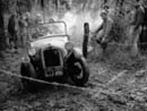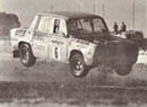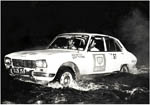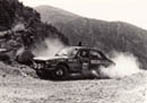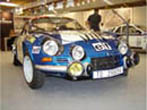Motorsport History
I became interested in motor sport after reading books written by Stirling Moss (Stirling Moss’s Book of Motor Sport, 1 and 2), and seeing cars starting the first Redex Trial in Sydney in 1953. The sight of the huge field of rally cars covered in advertising stickers and about to embark upon a huge adventure driving around Australia kindled an interest in rallying that has lasted 55 years and shows no sign of abating.
At age 15 I purchased an Austin Seven for £17.10.0 and with the help of my father towed it home and pulled it to pieces. Having no money, I reassembled everything as it was, and used the car in “chassis” form to compete in motorkhanas and autocrosses run by the Austin Seven Club of Victoria. I built an aluminium sports body for the car with my father’s help, and had the car registered the day after I obtained my driving license (which was on my 18th birthday). This meant I could compete in navigation trials run by the club, but I soon became aware that the Austin, although an incredible little car, was not suited for serious car rallies. Foolishly I stuck with the marque and purchased an Austin A30, which was almost as unsuited for rallying as the Seven.
Working at Holdens, obviously one of their products would be more realistic to own, so I bought a 48/215, black, suspected ex taxi. In this car I tackled some higher level events, navigating for a Holden colleague, Marc McInnes. At that stage I merely wanted to compete, and had no great aspirations to become a great driver or navigator.
Holdens had an attractive employee purchase system for new cars, so my next investment was a brand new 1962 EJ Holden. This car did a season of rallying including some championship events, using various navigators from the GMH Motoring club.
The much faster EH model with 179 cu in engine was released in 1963 and I bought one. I had settled with a permanent navigator, Jim McAuliffe, who also purchased an EH 179, and we ran most Victorian championship events in 1963 in his or my car, with mostly unimpressive results. Ford was running a strong factory rally team in the same events with the top crews of the time so success was unlikely, but at least we were showing the flag for Holden.
In 1964 Holden initiated a full time rally team to counter Ford’s rally successes and advertising. The Holden cars were run under dealer’s names, as GM world wide had an official “no motorsport” policy. One of the team cars, nominally entered by Preston Motors, was allocated to the GMH Motoring club, and myself and Jim McAuliffe were allocated the car. Success soon followed, as we won our first Victorian championship event, the Akademos Rally in 1964. In spite of some individual successes for the Holden team in 1965, Ford were still winning the major events such as the Victorian Championship, the BP Rally of South Eastern Australia and the prestigious Alpine Rally.
Things turned around dramatically in 1966, when our team mates Tony Roberts and Peter Haas (all of us Holden employees) won the trifecta: the BP Rally, the Alpine Rally and the Victorian Championship. Jim McAuliffe and I had a bad year, having several crashes in the evil handling HD model.
At the end of 1966 I decided to take a sabbatical, and went to the UK to work at Vauxhall for twelve months. Veteran sports car racer Ron Phillips took my seat beside McAuliffe in the HR model, but again the Victorian championship eluded them. I returned to Australia in time to compete in the Alpine Rally in a spare HR rally car, and despite losing third gear in the Opel gearbox managed to finish third.
1968 saw a long awaited turn around in fortune for McAuliffe and myself. The Holden team rallied HK V8 models with two speed automatic transmissions. Ford had reduced its rally involvement, so we only had our team mates, Tony Roberts and Mike Osborne, to beat. We won five of the championship rounds and finished second in the sixth, giving us our long awaited Victorian Championship. Our car lost a wheel in the Alpine Rally and Roberts had an unlikely win in a Brabham Torana.
At the end of 1968 Holden closed down its rally program, following Ford into long distance touring car racing using the Monaro GTS 327. I was involved closely in the development of the GTS 327 into a racing car as part of my work in the Experimental Department at Holden, and Tony Roberts was keen to purchase one to go track racing, so I was pleased when he invited me as co-driver. I felt my knowledge of the car would make a good contribution.
Being racing novices, we had to obtain a full racing license to race at Bathurst, our ultimate aim. We planned three race meetings before Bathurst, sufficient to obtain our full licenses barring any incidents. Our first meeting was at Hume Weir circuit at Albury, where we ran a Toyota Corolla borrowed from Brian Sampson. I managed to win a handicap race, which was a big thrill. We then took the Monaro to Mallala in South Australia and had a trouble free meeting there.
The Sandown 3 hour race was our next target, but in the meantime we discovered on checking the CAMS Manual of Motor Sport that no long distance records had been set for the Monaro’s class. We hired the Sandown track two weeks before the three hour race and set some distance records to gain publicity and hopefully sponsorship for the major races. We obtained fuel and tyre sponsorship and ran the Monaro around Sandown for 24 hours non stop (apart from refuels, driver changes etc), setting 16 new records for the CAMS book. This exercise gave us invaluable knowledge of tyre and brake wear rates on the Monaro, which would stand us in good stead for the Sandown three hour race.
In the Datsun Three Hour Trophy race two weeks later, our first race in the big time, Tony qualified the car 5th, and took the first driving stint. Other Monaros experienced brake problems due to excessive wear of the rear linings, a problem we had experienced and rectified during the record run. At the compulsory refuel/driver change, we decided not to change the front brake pads while all of the other Monaros did. This put us into third place behind the Porsche of Alan Hamilton and Brian Foley’s Alfa Romeo, but Hamilton’s co-driver was well off the pace, and the Alfa broke a front wheel at Dandenong Road corner.
We were winning. Then, with ten or so laps to go, the brake pedal went rock hard under my right foot, and there was no retardation. I carried on, as stopping would certainly cost us the race. I was slower by around 8 seconds per lap with no brakes, and the second car, a Monaro driven by soon to be F1 World Champion Alan Jones, was gaining steadily by that amount. Fortunately we made it, winning by 8 seconds. One more lap may have cost us the race.
We ran at Bathurst in 1968, a private entry pitted against factory teams from Ford and Holden. With $200 sponsorship from Holden dealer Cullens of Liverpool and fuel and oil support from BP, we finished third outright, for a total outlay of around $2000.
When the 1969 rally season loomed, the former Holden crews were without vehicles to drive. I was approached by Renault Australia to drive a Renault R16, which I accepted. Tony Roberts snared the factory Porsche from the 1968 London to Sydney marathon, so McAuliffe and I did not fancy our chances too much. Surprisingly the Renault was better than we expected, and with some mechanical and navigation problems for the Porsche, we won our second Victorian Championship. Renault was extremely pleased.
For 1970 Renault decided on an all out attack on the Australian Rally championship inaugurated in 1968. The cars were R8 Gordinis, very successful in Europe, but yet to be proven in Australia. With 130 horsepower from the 1.3 litre engine, superb traction due to the rear engine, and four wheel disc brakes the cars were exceptionally fast, and very well prepared by Renault expert Bruce Collier in Sydney. We ran away from Harry Firth’s newly formed Holden Dealer Team Monaros and XU1s driven by top drivers including Colin Bond, Tony Roberts, Frank Kilfoyle and John Keran. McAuliffe and I won four of the five heats and were second in the other. We also had an easy win in the Victorian Championship, with very little opposition. Jim and I had won ten championship events in one season.
An inevitable effect of our success over the HDT was that my job at Holdens was put in jeopardy. Come mid year, the ultimatum was put: stop rallying with Renault or lose your job. I asked why I could not join the new HDT, but was told that was not an option for Holden employees. Fortunately I had covered my bets with Renault, and left Holden to become Rally Competition Manager at Renault. Jim chose to stay at Holden so our very successful partnership was brought to an end.
The 1971 Australian Championship season started well with new navigator Andy Chapman, with an easy win in the first heat. However a series of component failures in the limited slip differentials of the cars cost us several DNF’s and we could only finish second in the championship.
As well as dominating rallies in 1970, we entered the new sport of rallycross, The format was four cars racing together over a circuit which was partly tarmac and partly dirt, with a few water splashes and jumps to add some action. Rallycross became very popular, and was televised live from Calder raceway for three hours on Sunday afternoon, so it was great value for the sponsors, Coca Cola. We built a lightweight Renault R8 Gordini to compete against ex marathon Porsches, Peter Brock’s supercharged Torana XU1, hot Minis and a lightweight Ford Lotus Cortina driven by Allan Moffat. The little R8 won outright at the first meeting, and several times thereafter. Similar meetings were held at the old Catalina Park race circuit at Katoomba in NSW, and I managed to win the first event there too.
During 1972 some exciting things happened. Renault decided to enter a car in one of the world’s toughest rallies, the East African Safari. We would use an R12 Gordini, one of the five sent to Australia for the 1972 rally year. The car was prepared and shipped to Dar-es-Salaam in Tanzania for the start of the rally. Two other Aussie crews (Evan Green/George Shepheard and Stewart McLeod/Peter Huth), both in XU1 Toranas, were also entered. Unfortunately we crashed out early in the event, but we did outlast the two Toranas.
In 1972 Renault Australia also wanted to push sales of the Peugeot 504, and entered a standard car in the demanding 2500 km BP Rally. My navigator was Geoff Thomas, very experienced in this particular rally, and with his excellent navigation and the car running comfortably and reliably we won the event. Renault, needless to say, was ecstatic. We followed this up with a win in the very difficult Experts Trial in the same car.
In 1973 Renault, through a combination of failing sales and lack of a competitive rally car, stopped its rally operations, so I joined Bendix Automotive as their resident engineer at Holden. In the meantime Jeff Beaumont and I had scored some points towards the Victorian Championship early in the season, so I approached Harry Firth to supply us with a car to continue the championship. Standing idle was a HQ Kingswood V8 that had been built for Peter Brock to run in the Hattah desert rally, so we did a deal. The Kingswood was a great car and we went on to win several events and take the Victorian Championship again.
At the end of 1973 I was offered a drive in the Southern Cross Rally in a factory Datsun 240Z, navigated by Jeff Beaumont. Datsun, (Nissan) were desperately trying to win the Southern Cross event because it provided good advertising in Asia, but they were frustrated by Andrew Cowan’s invincible Mitsubishi Lancer. We had a strong team with Rauno Aaltonen, Tony Fall, East African Safari winner Shekhar Mehta, Frank Kilfoyle and myself, but Cowan won again. It was a tough wet event and we finished eighth of the nine cars that completed the entire course.
At the start of the 1974 season Datsun Competition Manager Bruce Wilkinson offered Jeff and I the Datsun 180B SSS that Kilfoyle had driven in the previous Southern Cross. It was a good car and we had a promising start in the first Victorian event. Then a wild card appeared, in the form of a world championship winning Renault Alpine A110, imported by Renault for shows and dealer displays. I was offered the car to drive in a new rally, the Don Capasco, to be run in the forests around Canberra in true European style. This was a golden opportunity, although Wilkinson did not agree and Jeff and I were ousted from the Datsun team. We won the Don Capasco (later Castrol) Rally very easily against strong opposition. The car was superb. The Alpine A110 was also entered for the 1974 Southern Cross Rally, but small mechanical problems and a failed ignition coil caused the car to DNF.
1975 saw another change of rally car marque. Although temporarily out of motor racing, Ford Motor Company had imported an ex factory Mark 1 Escort BDA rally car to be run privately by Howard Marsden. The car was left hand drive, and the navigator was Jeff Beaumont. First event was the 1975 Don Capasco Rally. The Escort was very fast, but drowned the ignition system in creek crossings, which meant numerous delays. While trying hard to make up time the rear suspension was damaged and the car retired.
The Escort was run in a number of Australian championship events, but dust entry into the engine during the first rally meant an engine rebuild was required and subsequently the engine was well down on power. A few minor placings were achieved but the true potential of the car was never realized.
There was no rally program for me in 1976. Our son Daniel was born, and spare time was spent on renovations to our Elwood house. I did build a Renault engined off road buggy so that I could get a taste of off roading, and competed in a couple of desert rallies, but when I gained a rally drive for 1977 the project was shelved.
For 1977 I was offered a drive with the Canberra based Gerry Ball Rally team. Former team driver Greg Carr had joined the official Ford team, but his navigator Wayne Gregson elected to stay with the Ball team and navigate for me. We ran a highly modified Datsun 120Y, finishing second in the Castrol Rally. A series of mechanical failures caused DNFs in early events and the priority for the season then shifted to the Singapore Airlines London to Sydney marathon event, in which Gerry Ball was also a competitor.
I was offered the position of team manager for a team of privately entered Peugeot 504s for the Marathon. The private entrants would buy the basic cars which would then be rally prepared by the Peugeot competition department in France. However industrial problems at Peugeot France meant that the cars and the parts to prepare them were hastily shipped to London, where the team members and Peugeot UK mechanics had to prepare the cars.
The cars were prepared in time for the start, but unfortunately the Peugeot 504 wagon entered as a mobile service car for the team and driven by accomplished rally driver/mechanic Gil Davis crashed in eastern Turkey. The three team cars reached Australia well placed, but one crashed and one suffered overheating, leaving the remaining Dunkerton/Watson/Bonhomme car to finish 5th outright, first in class and first all Australian crew.
1977 finished with two more events for the Gerry Ball team. For the Southern Cross Rally the team ran a Datsun P 710 Violet single cam loaned by Nissan. The car was built up from various left over parts from the Nissan competition department. I had a new navigator Peter Godden, who was excellent, and with heavy attrition in the field we finished 3rd outright and first Australian crew, behind two internationals, Rauno Aaltonen and Harry Kallstrom.
The final event for 1977 was the Alpine Rally. The Gerry Ball team ran a Datsun P 210, loaned by Nissan, a factory car which had been used in the Southern Cross rally by Shekhar Mehta. The car held third position behind the Escorts of Carr and Bond for most of the rally, and moved into the lead when the Escorts struck problems. With 30 kms to go and leading, the flywheel failed leaving the Datsun with no drive. 36 tyres were used during the event.
1978 For the first part of the season I drove a Ford Escort Mk 2 managed by Gerry Ball with some minor success but this tailed off as Bob Watson’s Service Centre was established in Hawthorn, Victoria, in partnership with Bruce Shepherd. Initially all efforts were put into making the business a success but as the client base increased I felt there was an opportunity to go rallying again. Renault Australia agreed to let us use the Singapore Airlines Marathon ex marathon Peugeot for the Victorian Championship, although no financial support was provided.
We had Graeme Ritter turbocharge the car to make it competitive, and it was ready for the 1978 Alpine Rally, but various problems, culminating in a roll over, saw us look to 1979 for some success. More development was required during the 1979 season, but we managed to win one championship event, the Otways Trial. In the Alpine rally third gear failed, but even so we were holding 6th place on the final stage when the engine threw a connecting rod, the constant over revving taking its toll.
We fitted an alloy 2.8 litre V6, unit being used by Peugeot, Renault and Volvo. Graeme Ritter fitted a turbocharger, and the power output was very impressive. However because of the low geared steering and good traction due to the independent rear suspension the car was a handful to drive, understeering badly, although it did win the first ever rallysprint event held in Victoria.
Then we decided to build a replica of a Renault R5 Turbo, hoping this would be more user friendly. These cars were successful in Europe, so we purchased a Renault 5 belonging to the wife of a Renault Australia executive. This was a standard small engined front wheel drive model, so we stripped it down, cut a large hole in the rear floor and started building a four wheel drive mid engine car.
This took almost twelve months of after hours work by Bruce Shepherd, Pete Pender and me. Ian Kelly of Aviation Welding also did a wonderful job of welding and fabricating. Graham Ritter turbocharged the modified Renault R16TS engine and gearbox whizz Peter Holinger built us a special gearbox. The car was fast, but required a lot of development, and unfortunately we, the builders, had run out of steam to finish the project properly. The car was purchased by Bill Hamilton, who updated it factory panels. It is now owned by Rob Sealey who has restored it to pristine condition.
The R5 Turbo won one Victorian championship heat, but persistent blown head gaskets and other problems brought the project to an end. The end came when a rule change banned highly modified or special one off cars. This was my last serious effort in championship level rallies.
In 1984 I purchased a Porsche 911 1970 2.2 litre S model, fulfilling a long held ambition. I used it as daily transport for some years and in 1988 I had it restored by Porsche specialist Mike Tankard, and have gained great pleasure from it ever since. It has competed in numerous Grand Prix rallies, Targa Tasmania, the Classic Adelaide Rally and Rally Tasmania.
One could say that one has not had a complete rally career without driving the ubiquitous Datsun 1600. I purchased one in 2003 from Penny Swan and have competed in many Historic Rally Association events since, gaining great enjoyment both from the car and the competition. The honest Datsun finished the Alpine in 2003, 2005 and 2007, and the Old BP Rally in 2008 and 2010. The engine failed on the last stage of the Alpine in 2009, although we finished, and I missed 2011 (which would have been my 20th Alpine) due to my back problems. Dave Johnson now owns the car and we will be competing in the 2013 Alpine in it.

